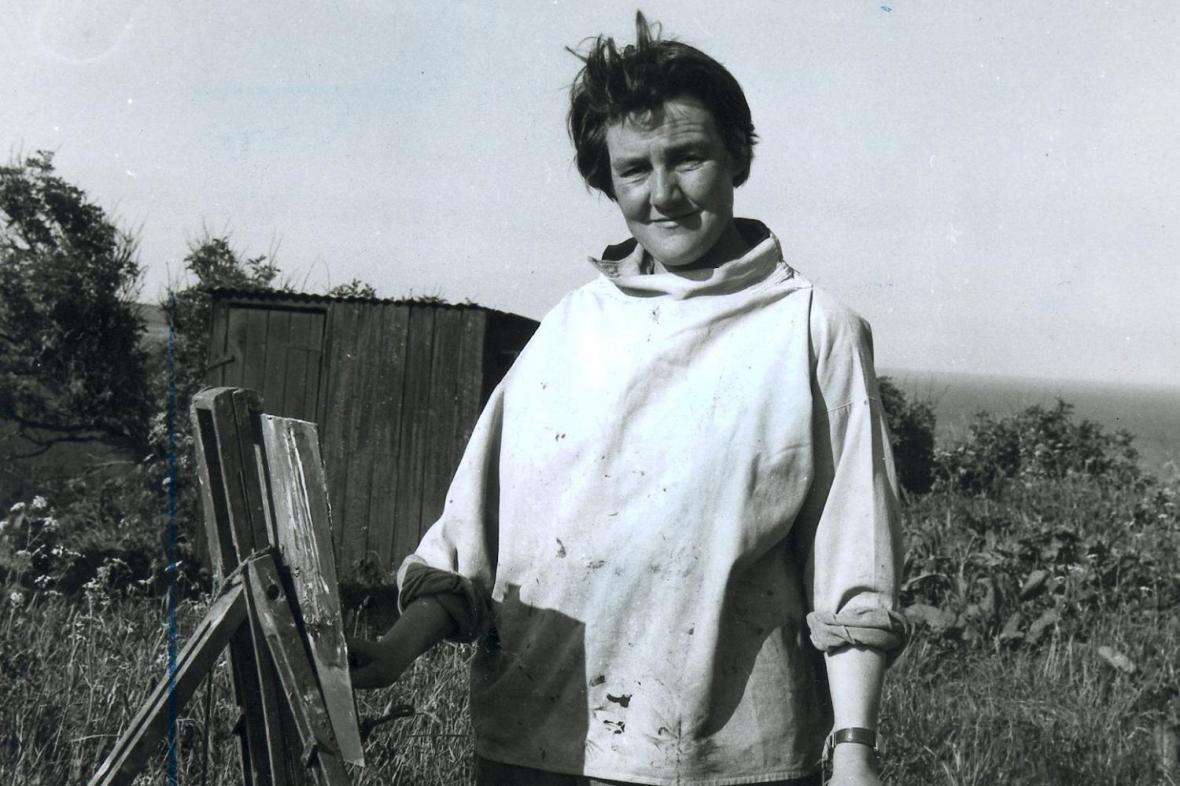
Image © Audrey Walker
Joan was seven years old and her sister Patricia five when, in a slough of depression, William Eardley ended his life. Joan seldom spoke of this trauma in later years. Perhaps, indeed, her own recurring bouts of depression brought the thought of her father’s depression too close for comfort…
Cordelia Oliver, Joan Eardley, RSA, Mainstream, 1988
Born in 1921 on a dairy farm in Sussex to an English father and a Scottish mother, Joan Eardley’s life changed dramatically in 1926 when the family farm failed and her father had a breakdown.
William Eardley had fought in the First World War and never got over the trauma suffered as a result of being gassed in the trenches. He drank heavily when his daughters were young and suffered a breakdown in 1926 as a result of what today we would call Post Traumatic Stress Disorder (PTSD).
While William took a peripatetic job working for the Ministry of Agriculture, Joan moved with her mother, Irene, and younger sister, Pat, to Blackheath in London. There, they stayed in an all-female household with her grandmother, Ellen Morrison, and her aunt, Sybil Morrison, a well-known suffragist who went on to become a leading light in the Peace Pledge Union.
In 1929, William Eardley committed suicide; a fact concealed from Joan and her sister until they were grown women.
Thanks to the generosity of their great-aunts, Joan and Pat were educated privately in Blackheath. At St Helen’s School in nearby Northwood, Joan’s artistic talent was spotted by her art teacher, Miss Waddland, who persuaded Joan’s mother to allow her to go to art school. As a result, Joan spent two terms at Blackheath School of Art. This was followed by two terms at Goldsmith’s College.
On the outbreak of war in 1939, Joan and her grandmother went to Auchterarder in Scotland to stay with family, while Irene and Pat remained in England (Pat having been evacuated with her school). Irene and Pat followed in January 1940 and the three generations of women (with the exception of Aunt Sybil), moved to 170, Drymen Road in Bearsden, a suburb to the north west of Glasgow.
If you want to become a good painter, and I mean one who matters beyond the ordinary kind of success with people around you, you have to be prepared to break down some kind of barrier within yourself.
Hugh Adam Crawford
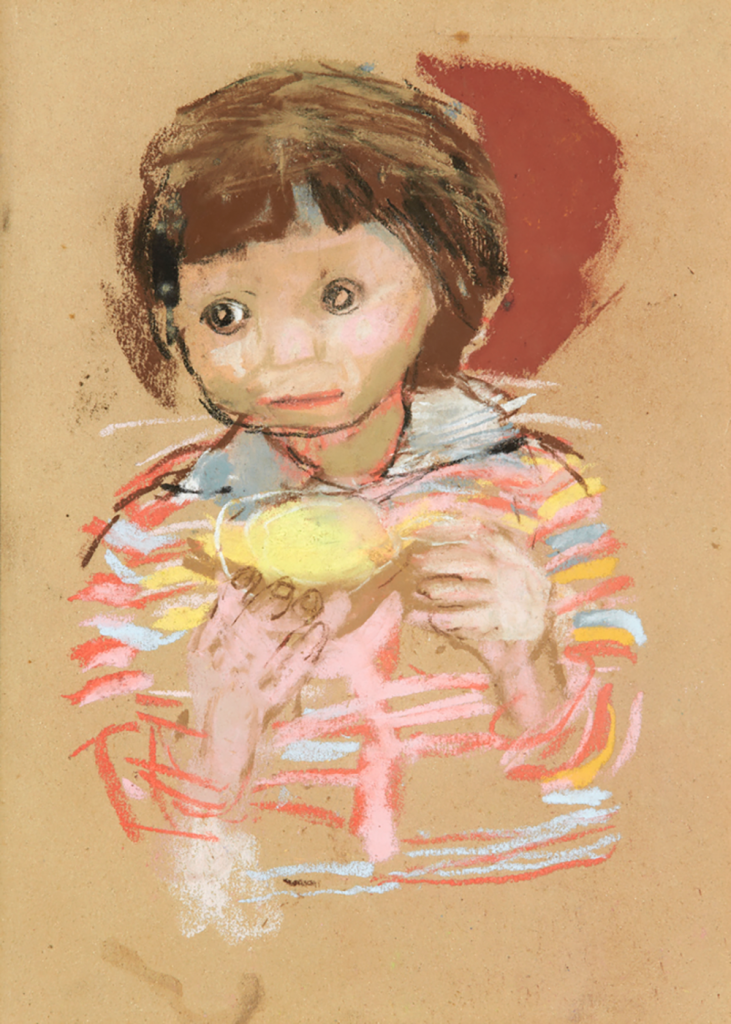
Girl with Striped Cardigan and Piece, gouache and pastel on paper.
Private collection. ©Joan Eardley Estate
The Glasgow School of Art
Joan arrived at The Glasgow School of Art (the GSA) in January 1940 at a time of great upheaval for staff and students alike. The start of term in September 1939 had been delayed while air-raid shelters were built in the basement of the Charles Rennie Mackintosh-designed art school. In this particular academic year, the usual student population at the GSA had been cut in half from 1,200 to 600 students and it continued to fall for the duration of Joan’s time as a student as staff and students were called up for service.
As a result, the remaining students, including Joan and her friend, Margot Sandeman, got to know the staff well and vice versa. The Head of Painting at the GSA was Hugh Adam Crawford, a skilled portrait painter himself, who acknowledged Joan as one of the two or three outstanding artists to come under his tutelage.
In the summer of 1942, Joan joined Margot and her family on a family holiday at Corrie on the island of Arran. The pair spent several summers there in the years that followed, drawing and painting the surrounding countryside and local worthies, including the imposing figure of Mrs Kelso and her old relative, Jeannie.
Joan’s Diploma self-portrait was bought by her teacher, Hugh Adam Crawford, who went on to hang it in his own home. A few years later, Crawford included Joan’s self-portrait in a work he painted in his home. His interior scene was also called Self-Portrait and is now in the collection of the Scottish National Portrait Gallery.
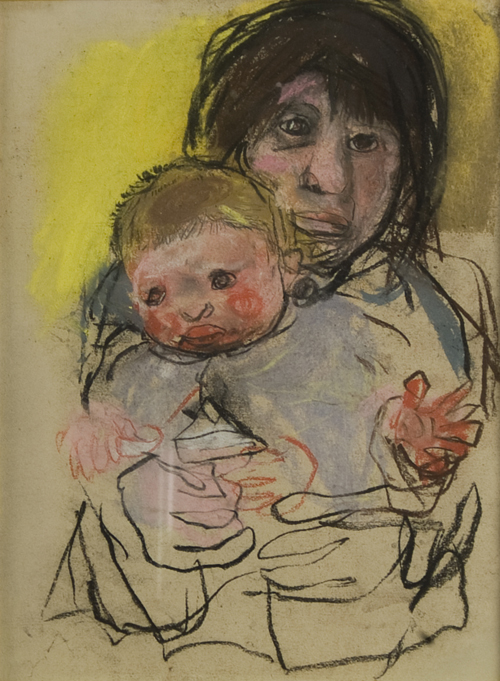
Big Sister, c.1959, oil pastel on paper.
Private collection. ©Joan Eardley Estate
I think I will have to be very strong to stand against Mr Cowie, and I don’t feel very strong just now – he asked me if I had changed my way of painting since I left the art school, and when I said, yes, that I was trying to tighten it up a bit, he said “I’m very glad to hear it – this self-expression business is not good at all.
Joan Eardley writing to her mother from Hospitalfield in 1947
Starting Out
After leaving the GSA, Joan spent a term at Jordanhill Teacher Training College in Glasgow before realising she was not cut out for teaching art. A period as a joiner’s labourer, a reserved occupation in war time, followed before she gradually began to forge a successful career as a painter.
Glasgow in the early 1940s was a hotbed of creative activity, with emigré artists such as Polish painters, Jankel Adler and Josef Herman, both living in the city. JD Fergusson, then in his sixties, returned to Glasgow with his partner Margaret Morris and created spaces for fellow artists to exhibit and discuss art.
Joan got to know Herman well. Years later, he recalled meeting Joan and Margot Sandeman on the stairs outside his studio. “Joan, though unbelievably shy – she could not utter a word without going red in the face – came frequently to my studio after this first meeting,” he said.
Joan started to exhibit in the big annual exhibitions, including the Royal Glasgow Institute, the Society of Scottish Artists and the Royal Scottish Academy. By 1945, she was included in a prestigious exhibition mounted by the Council for the Encouragement of Music and the Arts, called Watercolour and Drawings by Living Scottish Artists.
In 1946, Joan spent several months in Donington, Lincolnshire, working on a commission for a mural on the history of costume for a girls’ school. No trace has been found of the mural, but Joan – taken with the rural setting as a rich seam of subject-matter – created several drawings and paintings during her stay.
The following year, she studied for six months at residential art school, Hospitalfield in Arbroath under its fierce-yet-fair warden, James Cowie. This experience allowed her to concentrate on her art, against a backdrop of several battles of will with Cowie, an artist who had no truck with painting which veered towards expressionism or gestural freedom.
Joan drew and painted incessantly around the harbour in Arbroath, capturing its working life and the big seas and skies beyond. Scotland’s north east coast began to seep into her soul.
At Hospitalfield Joan befriended Angus Neil, a former soldier and joiner, who was three years her junior. The two would remain friends and helpmates until her dying day.
…the beauty lies in the things exactly as they are – no distortions or isms.
Joan Eardley in a letter to Margot Sandeman, April 1949
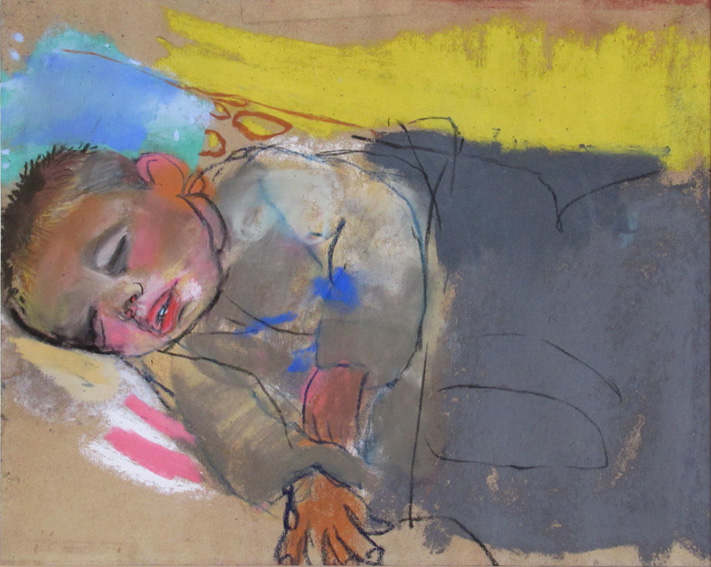
Sleeping Child, c.1962, pastel on glass paper.
Private collection. ©Joan Eardley Estate
Keeping it Real
In January 1948, Joan began her postponed post-Diploma year at the GSA with her attention fixed on kitchen sink realism. Typically, drawings and paintings from this period depict stoves or water closets stored in a plumber’s yard.
At the end of the session, she was awarded £200 from two scholarships; one from the GSA and the other, a Carnegie scholarship, from the Royal Scottish Academy’s students’ competition. This allowed her to travel and work in Italy for eight months, from September 1948 to May 1949.
In Italy, she went in search of real people and places. In Florence, she explored Giotto and Masaccio‘s frescoes with a giddy sense of “coming home”. After a visit to see Masaccio’s incomplete fresco at the Church of Santa Maria del Carmine, Joan noted: “… we realise that in the same way that all individual single people in all nations today are the same and have the same worries and thoughts and fears.”
Often dogged by depression and wracked with self-doubt, her head teemed with the hustle, bustle and visual stimulation of everyday life in Italy. She wrote home about the clean, pure colours. “Pale pink, pale blue and yellowy and white right into the distance.”
Joan arrived back in Scotland in spring 1949 with sketchbooks crammed full of drawings and a small number of rolled-up oils on canvas. Her first solo exhibition, Drawings of Italy, was held in the GSA’s Mackintosh building. A Glasgow Herald critic wrote that she was “notable among the immediate post-graduate generation […] for the strength and selective quality in her drawings.”

Two children before lettered wall, oil & collage on board.
Private collection. ©Joan Eardley Estate
I like the friendliness of the back streets. Life is at its most uninhibited here. Dilapidation is often more interesting to a painter as is anything that has been used and looks used – whether it be an ivy-covered cottage, a broken farm cart or an old tenement…
Joan Eardley
Glasgow
When she returned to Glasgow in 1949, Joan rented a studio at 21 Cochrane Street on a street adjacent to Glasgow’s City Chambers. Later, in 1953, she moved into a ramshackle photographer’s studio at 204, St James Road, also in the Townhead district of Glasgow. The whole area, with its clutter of new buildings, half-demolished old ones and obliterated streets, was on the cusp of change as redevelopment swung slowly into action.
To Joan, it was meat and drink. She had a bed in the studio, so could stay over, but was still based in Bearsden. She found her subject matter in the street life around her studio; in the people – mainly the curious children – and in the buildings.
For around ten years, she drew and painted the Samson family, who lived in a two-bedroom tenement flat a short walk from the studio. There were 12 children in all, so Joan found ready child models of all ages and stages.
Joan started to visit an art college friend, Dorothy Steel, at her home in Gourock in 1950 and was introduced to Port Glasgow, where Stanley Spencer had painted during the war. She produced many drawings and paintings of people and places against this industrial landscape.
Her friend Angus Neil became a favourite model. A memorable work from this period is a painting of him called Sleeping Nude, exhibited at the Royal Glasgow Institute in 1955. Glasgow Herald critic, Alistair Philips, described it as “a miserable realism for such an expressive hand.” The painting attracted lurid interest from the Sunday Express and was featured under the headline: “This sleeping man has (oooh!) no clothes.”
Joan’s star was in the ascendent. In 1954, she was invited to take part in Six Young Painters at Parsons Gallery in London. The following year, by which time she had been elected an Associate of the Royal Scottish Academy at the age of 34, she had her first solo exhibition in London at St George’s Gallery in Cork Street.
In a review, the Glasgow Herald’s London critic described her portraits of Glasgow children as “truly remarkable”.
She lived so quietly among us and was accepted as one of us.
Joan’s Catterline neighbour, Ruby Coull, in a letter to Audrey Walker after her death.
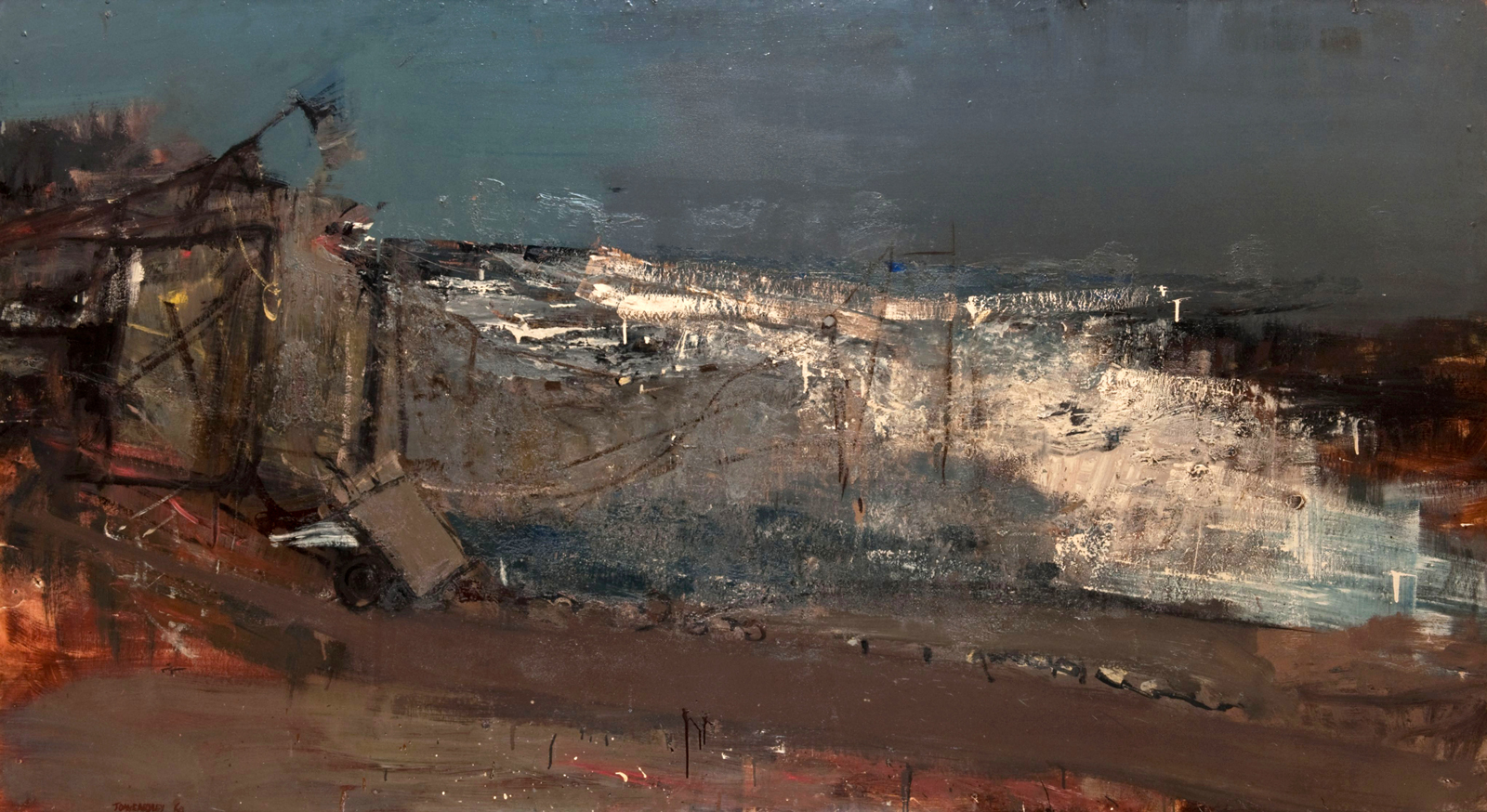
Salmon Nets and the Sea, 1960. (The Hunterian, University of Glasgow)
©Joan Eardley Estate
Catterline
From 1952, until her death in 1963, Joan divided her life between her studio in Townhead, and Catterline, a small fishing village south of Stonehaven on the Scotland‘s north east coast.
In this isolated spot, perched on the edge of a cliff facing onto the North Sea, Joan created a large body of landscapes and seascapes. She first went to Catterline in 1951 with Annette Soper, an art teacher friend from Aberdeen. During the run of a solo exhibition in Aberdeen, Joan contracted mumps and her visit was part of an extended convalescence. Within a year, Annette had bought the Watch House, an ex-Customs and Excise look-out on the edge of the village, and with Joan and Angus’ help made it wind and water-tight. It became a base from which Joan and Annette would paint. In 1952, after Annette married local fisherman, Jim Stephen, Joan was given free use of “The Watchie'”.
Joan would go on to live and worked in a few properties in the village, first renting and then buying; No. 1 South Row, at the opposite end of the village from The Watchie and No.18.
The buildings, shoreline, cliff-face, wild boiling seas and surrounding farmland provided endless material for Joan. Usually painting on hardboard outside, she employed all sorts of media; including artist’s paint and boat paint, with newspaper, sand and grasses layered into the mix. She used a palette knife to create texture, dribbling paint onto the foreground and using the sharp end of her brush to draw into the wet paint.
As a gay woman at a time when it was not the done thing to openly acknowledge one’s sexuality, she was accepted as one of Catterline’s own, living openly with partners, including Dorothy Steel and Lil Neilson.
The photographer, Audrey Walker, whom Joan met in 1952, was a regular visitor, as she was in her Glasgow studio. Angus Neil was also an on-off resident.
Joan loved the changing moods of the weather and the seasons in Catterline. She would receive a phone call in Glasgow whenever a storm was coming in and would put her Lambretta LD on the train from Glasgow before disembarking at Stonehaven and doing the last bit of her journey by scooter.

Winter Day, Catterline, c.1957-60, oil on calico, laid on board.
Private collection. ©Joan Eardley Estate
Joan Eardley’s life was a paradox. She was shy and gentle, yet powerful; she understood the lives of children, yet had none of her own; she painted not only the city, but also the sea and the seasons of the year; and while her creative power was flowing fiercely her life was extinguished.
Joan Eardley by William Buchanan, University Press, Edinburgh (1976)
an Early death
In February 1963, Joan was elected an Academician of the Royal Scottish Academy; a peer-led honour awarded to artists of note. In March, she entered into a frenzied period of painting at Catterline. By April, Joan was gravely ill. In a letter to Lil Neilson, dated 18 May (her 42nd birthday), Joan wrote that she had been told by a doctor she had breast cancer. Despite this, she still managed to attend the opening of her solo show at London’s prestigious Cork Street gallery, Roland, Browse & Delbanco in May 1963.
Back in Catterline, suffering from unbearable headaches and double vision, she was forced to rest in between courses of radium treatment at Aberdeen Royal Infirmary. By July, the cancer had spread to Joan’s brain. Nursed by friends, all she could do was sit in her cottage with a red spotted handkerchief over her eyes to keep the bright summer light out. One of her last paintings was A Jar of Summer Flowers, a poignant nod towards the fact she could not paint outside any more but was still itching to paint. By the end of July, her family were informed of her failing health and it was decided that she should move to Killearn Hospital in Stirlingshire, a half-hour drive north from Bearsden.
Joan endured a final train journey from Aberdeen to get there. En-route, as the train passed through Stonehaven, her friends from Catterline stood on the platform and waved in the window of her compartment. By this stage, untreated breast cancer had spread to her brain and she was lying blind on a stretcher.
Joan Eardley died on 16 August, 1963, at Killearn Hospital with her mother Irene, sister Patricia and Audrey Walker by her side. She was 42.
Her ashes were returned and scattered on Catterline’s shoreline, where until a few months earlier she had been a familiar figure in her old RAF flying suit and heavy boots. It was here at Catterline that Joan Eardley felt most at home; her eyes trained on the ever-changing scene in front of her eyes as she squared up to a blank canvas.
–
Joan’s Story
1921
Born on 18 May in Warnham, Sussex at Bailing Hill Farm to a Scottish mother, Irene and English father, William Eardley.
1923
Sister, Pat is born.
1926
Her shell-shocked father has a breakdown and family farm fails. Irene, Joan and Pat move to Blackheath in London to live with Irene’s mother, Ellen Morrison, and her sister, Sybil Morrison.
1929-39
William Eardley takes his own life. Joan and Pat are educated privately in Blackheath thanks to the largesse of great aunts. Joan’s talent is spotted by an art teacher and she attended Goldsmith’s in London before the family moves to Scotland to escape the bombing in London in 1939.
1940
The Eardley women and the girls’ grandmother move into a house in Bearsden, north of Glasgow. Joan enrols at Glasgow School of Art.
1942-46
Joan and Margot spend several summers in Corrie, on Arran. Joan takes the diploma drawing and painting prize at the GSA winning the Guthrie Prize for her only self-portrait. After a term at Jordanhill Teacher Training College, Joan realises it isn’t for her and does war work at a joiner’s labourer in Bearsden. Attends evening classes at GSA.
1946
Joan paints a commissioned mural in a Lincolnshire girls’ school
(now lost).
1947
Joan spends several months in London before taking up a place at the Patrick Allan-Fraser College of art at Hospitalfield in Arbroath from April to September. Meets Angus Neil and clashes with the warden/painter, James Cowie.
1947-48
Does delayed post-graduate diploma at the GSA. Meets Dorothy Steel, a younger student at the GSA. Elected a professional member of the Scottish Society of Artists (SSA). Wins travelling scholarship from the GSA and Carnegie Scholarship from Royal Scottish Academy (RSA). Travels to Italy and briefly to Paris.
1949
Joan returns to Glasgow. Is given a solo show by the GSA of her Italian drawings and paintings. Takes on a studio on Cochrane Street next to Glasgow City Chambers in the Townhead district. Starts to paint local children after they see her in the street with her easel. Gives evening classes at the GSA.
1950
Starts visiting Dorothy Steel in Gourock. Dorothy introduces Joan to Port Glasgow where she makes industrial landscape drawings and paintings while capturing street life in the shape of local children. Invited to stage a one-woman show at the Gaumont Cinema in Aberdeen. While there, she lodged with a local artist and teacher, Annette Soper. Contracts mumps and while convalescing visits Catterline for the first time.
1951
Spends summer in small French village of Cologne du Gers with Dorothy Steel.
1952
Joan meets Audrey Walker, a former violinist turned photographer. Moves into a glass-fronted former photographer’s studio on St James Road, Townhead. Starts to work in Catterline, staying at The Watchie, now owned by Annette Stephen (neé Soper).
1954
Invited to exhibit in a group show at Parson’s Gallery in London. Moves into No. 1 Catterline. Writes to Audrey walker every day.
1955
Joan is elected an Associate of the RSA. Offered a one-person show at St George’s Gallery on Cork Street, London. Also a show at the Scottish Gallery in Edinburgh during the annual Edinburgh Festival.
1959
Buys No. 18 Catterline while keeping on No. 1 as a studio cum store. One of eight well-known artists featured in a ‘critic’s choice’ exhibition at Tooth’s Gallery in London.
1960
Guest tutor at Hospitalfield in summer. Meets Lil Neilson and invites her to Catterline.
1961
Major one-person show at the Scottish Gallery in Edinburgh.
1962
First signs of serious illness. In December, she has a short holiday with Dorothy Steel in Mentone, France.
1963
Elected an Academician of the RSA. Frantic period of painting in Catterline follows before solo exhibition in May at Rowland, Browse & Delbanco in Cork Street, London. Attends opening but returns to Catterline gravely ill. Goes into hospital in Aberdeen for treatment for cancer which has spread to her brain.Transferred to Killearn Hospital in Stirlingshire. Dies on 16 August. Joan’s ashes are scattered on Catterline beach.
1964
Joan Eardley, RSA, 1921 – 1963, Scottish Arts Council Memorial Exhibition, Kelvingrove Art Gallery and Museum, Glasgow then Royal Scottish Academy and subsequent tour of shortened version.
Joan Eardley, RSA, 1921 – 1963, Edinburgh Festival Memorial Exhibition, The Scottish Gallery.
(Subsequent exhibitions there in 1981, 1984, 1988, 1990, 1992, 1996 and 2007)
Paintings by Joan Eardley, Rowland, Browse & Delbanco, London.
Joan Eardley features in Three Scottish Painters, a 22-minute film by Templar film studios, Glasgow, for the Scottish Committee of the Arts Council in conjunction with Films of Scotland, 1964.
1975
Joan Eardley, Scottish Arts Council exhibition at the Third Eye Centre, Glasgow.
1976
Publication of Joan Eardley by William Buchanan, Edinburgh University Press.
1983
Street Kids and Stormy Skies for BBC Radio Scotland compiled and produced by Vivien Devlin. First broadcast 20th anniversary of Joan’s death.
1985
Joan Eardley RSA, 1921 – 1963, Cyril Gerber Fine Art, Glasgow.
1988
Joan Eardley RSA, Retrospective Exhibition concurrently at Talbot Rice Gallery and the Royal Scottish Academy during Edinburgh Festival. Moves to Hayward Gallery, London.
Joan Eardley, presented and produced by Vivien Devlin for broadcast on BBC Radio Scotland on 29 March.
1992
Joan Eardley, Paintings, Pastels and Drawings, Mercury Gallery, London (jointly with Ewan Mundy, Glasgow and The Scottish Gallery, Edinburgh).
2007
Joan Eardley, The Scottish Gallery.
2007 – 2008
Joan Eardley, Retrospective Exhibition, Scottish National Gallery complex, Edinburgh.
Joan Eardley by Fiona Pearson, with an essay by Sara Stevenson, published to accompany National Galleries of Scotland exhibition.
2008
Joan Eardley Retrospective, The Fleming Collection, London.
2013
Joan Eardley, The Scottish Gallery, Edinburgh and Portland Gallery, London.
2015
Joan Eardley: Time & Tide, Clydebank Museum and Art Gallery.
2017-2018
Joan Eardley: A Sense of Place, Scottish National Gallery of Modern Art, Edinburgh.
Joan Eardley: A Sense of Place by Patrick Elliot with Anne Galastro published to accompany National Galleries of Scotland exhibition.
